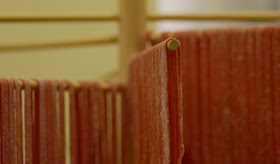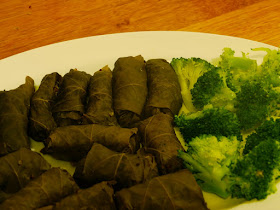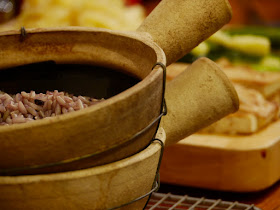
Seeing as how much my darling loves to eat pasta, and there being a sale at a kitchen store, we finally decided to buy yet another appliance - a pasta machine! Turns out for the recipe I tried, I didn't really need one - just a rolling pin and a knife. I used it anyway though to save on some rolling after all that laborious kneading - more on that in a minute.
So the first recipe I decided to try was from Diane Seed's 'More Great Italian Pasta'. Awhile ago I picked up a couple of her beautifully illustrated cookbooks at a second-hand store. I have no doubt that she manages fine with the recipe she provided, but it proved a bit of a waste of time for me, so I'm going to give you my adapted recipe of her Beetroot Tagliatelle.
Her recipe said to work together a pasta dough until smooth then mix in a cooked, pureed beetroot.
 You should have seen my hands! Covered with sticky pink gluey stuff with these little red lumps - one beetroot wasn't enough to work in my blender - and even scraped out with a spatula into bowl and mashed with a potato masher didn't get it 'pureed' exactly.
You should have seen my hands! Covered with sticky pink gluey stuff with these little red lumps - one beetroot wasn't enough to work in my blender - and even scraped out with a spatula into bowl and mashed with a potato masher didn't get it 'pureed' exactly.  Finally I managed to get it re-kneaded then rolled into these pretty pink sheets but I decided next time to add the beetroot with the eggs at the beginning. Another thing I decided was that while pretty little tangled nests of tagliatelle were all very um, curly, it really didn't seem worth the effort and fettucine using the machine's attachment was my choice the second time around.
Finally I managed to get it re-kneaded then rolled into these pretty pink sheets but I decided next time to add the beetroot with the eggs at the beginning. Another thing I decided was that while pretty little tangled nests of tagliatelle were all very um, curly, it really didn't seem worth the effort and fettucine using the machine's attachment was my choice the second time around. See how it's just rolled up and sliced? Then the background shows little piles of drying tagliatelle. Kinda fiddly.
See how it's just rolled up and sliced? Then the background shows little piles of drying tagliatelle. Kinda fiddly.So Here's a beetroot pasta recipe (serves 6)
600g (1 lb 4 oz) flour
3 eggs
pinch salt
2 T olive oil
about 200g drained, tinned beetroot / 2 peeled and cooked beetroots
In a large bowl put flour and salt. Make a well in the middle.
In a blender or food processor, whizz together the eggs, oil and beetroot. Pour this liquidy mixture into the well in the flour. Mix together with a metal spoon then tip out contents onto a clean, floured workbench and 'work together' - squeezing, kneading and punching, gathering up all the loose crumbs until it comes together as a ball. It shouldn't be too sticky - add more flour as necessary so that your hands stay clean as you knead it. Continue kneading until smooth, soft and springy.
Divide the ball into four pieces and roll out into rectangles no wider that your pasta machine. To do this I first rolled 'sausage' shapes with my hands then using a rolling pin, rolled along them. Dust each sheet with flour on both sides (so that it moves cleanly and easily through the machine) and hang from pasta dryer.
 Feed the rectangles, one at a time, through the pasta machine at it's highest (thickest) setting. Do this twice then cut each sheet in half so that the finished pasta doesn't end up too long. Keep the sheets hanging on the dryer when you are not using them so that they don't stick together. Adjust the pasta machine to the next thinest setting and pass each sheet through again. (Keep doing this until you have reached the thickness/thinness that suits you). Then pass the sheets through the fettucine cutter attachment and hang your pasta to dry - ready for you to cook and add sauce. I will add Diane's tips for filled pasta when I get around to trying to make those!
Feed the rectangles, one at a time, through the pasta machine at it's highest (thickest) setting. Do this twice then cut each sheet in half so that the finished pasta doesn't end up too long. Keep the sheets hanging on the dryer when you are not using them so that they don't stick together. Adjust the pasta machine to the next thinest setting and pass each sheet through again. (Keep doing this until you have reached the thickness/thinness that suits you). Then pass the sheets through the fettucine cutter attachment and hang your pasta to dry - ready for you to cook and add sauce. I will add Diane's tips for filled pasta when I get around to trying to make those! 
Leek Sauce
from Diane Seed's 'More Great Italian Pasta'
 See how in this photo the pink colour has just about disappeared? Not enough beetroot first time around. The sauce (and pasta) was delicious, though!
See how in this photo the pink colour has just about disappeared? Not enough beetroot first time around. The sauce (and pasta) was delicious, though!30 g (1oz) butter
3 leeks, sliced into fine rings (remember to always wash leeks well to remove sand)
200 ml (7 fl oz) cream
salt
black pepper
70 g (2 1/4 oz) freshly grated parmesan cheese
Melt the butter in a pan, add the leeks and gently cook them until soft.
Pour in the cream, season to taste and gently cook for 15 minutes.
Cook your pasta in boiling salted water till al dente. Drain and stir in the cheese then the sauce. Serve at once.
Rose's bright green sauce
invented tonight by moi

500g frozen peas
enough boiling water to cover said peas in a pot
5 sage leaves, chopped / 1 t dried sage
4 T cream (or use some pasta cooking water)
salt
1 bulb of garlic, roasted whole
'Garnish' ingredients:
3 beetroots, peeled, chopped and roasted in aluminium foil.
100g soft blue cheese (or goats cheese would be fab if you can afford it)
flat-leaf parsley
wrap beetroot in aluminium foil, put in ovenproof dish. Add the garlic bulb on top/ beside foil package in dish (do not unwrap the bulb's natural 'paper' covering. Roast in oven till soft (I took the garlic out before the beetroot).
In a bowl or pot, put the frozen peas and cover with boiling water. Leave to just soft (don't cook at all) then drain. In a blender, put peas, roast garlic cloves (unwrapped now!), sage and enough cream or water to make a sauce (add a little at a time as you whizz the mix). When you put on the pasta to cook, gently heat this sauce. You want it to be hot but still have that great bright green colour.
When pasta is al dente, drain, return to pot with a little olive oil and the roast beetroot. Toss together so the beetroot can impart some more of its reddness! Serve pasta in bowls or plates with a spoonful of the green sauce on top then a couple of slices of blue cheese (melts wonderfully) and parsley.











































